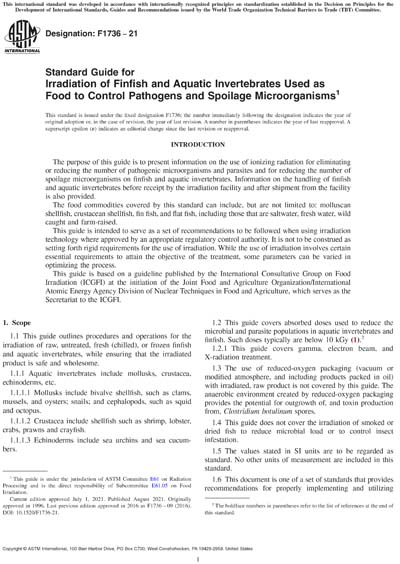Most recent
ASTM F1736-21
Standard Guide for Irradiation of Finfish and Aquatic Invertebrates Used as Food to Control Pathogens and Spoilage Microorganisms
1.1This guide outlines procedures and operations for the irradiation of raw, untreated, fresh (chilled), or frozen finfish and aquatic invertebrates, while ensuring that the irradiated product is safe and wholesome.
1.1.1Aquatic invertebrates include mollusks, crustacea, echinoderms, etc.
1.1.1.1Mollusks include bivalve shellfish, such as clams, mussels, and oysters; snails; and cephalopods, such as squid and octopus.
1.1.1.2Crustacea include shellfish such as shrimp, lobster, crabs, prawns and crayfish.
1.1.1.3Echinoderms include sea urchins and sea cucumbers.
1.2This guide covers absorbed doses used to reduce the microbial and parasite populations in aquatic invertebrates and finfish. Such doses typically are below 10 kGy (1).2
1.2.1This guide covers gamma, electron beam, and X-radiation treatment.
1.3The use of reduced-oxygen packaging (vacuum or modified atmosphere, and including products packed in oil) with irradiated, raw product is not covered by this guide. The anaerobic environment created by reduced-oxygen packaging provides the potential for outgrowth of, and toxin production from, Clostridium botulinum spores.
1.4This guide does not cover the irradiation of smoked or dried fish to reduce microbial load or to control insect infestation.
1.5The values stated in SI units are to be regarded as standard. No other units of measurement are included in this standard.
1.6This document is one of a set of standards that provides recommendations for properly implementing and utilizing radiation processing. It is intended to be read in conjunction with ISO/ASTM Practice 52628.
1.7This standard does not purport to address all of the safety concerns, if any, associated with its use. It is the responsibility of the user of this standard to establish appropriate safety, health, and environmental practices and determine the applicability of regulatory limitations prior to use.
1.8This international standard was developed in accordance with internationally recognized principles on standardization established in the Decision on Principles for the Development of International Standards, Guides and Recommendations issued by the World Trade Organization Technical Barriers to Trade (TBT) Committee.
Content Provider
ASTM International [astm]






